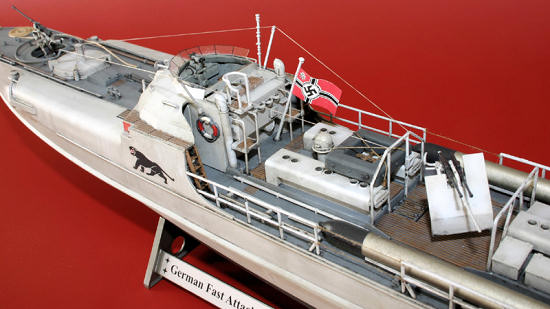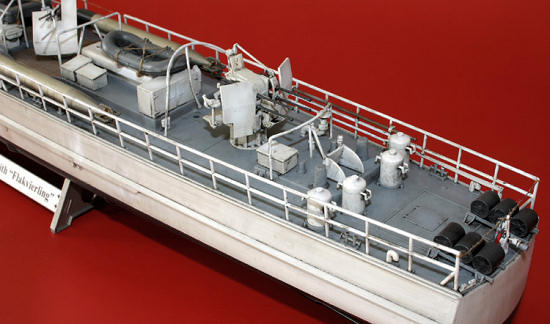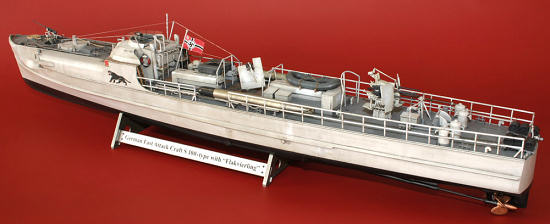Revell 1/72 S-100 Schnellboot.

Built
by the Lürssen company in Bremen-Vegesack, the
Schnellboot
(fast craft) design was originally based on a 1927 private motor yacht. In
post-WWI years, German naval construction was severely limited by the treaty of
Versailles,
so the Germans put great care into the few, mostly light types they could build.
The
“Schnellboote”
or “S-Boote”
were the primary attack crafts for coastal areas, and took over the role of the
classical torpedo boat. Several only slightly different classes of S-Boats were
built between 1929 and 1945.
Operating
in coastal waters, the offensive
S-Boote
(called E-Boats - Enemy boats -
by the Allied), were a very effective weapon. They took over the role of the
torpedoboats after those ships were more and more used for duty normally
fulfilled by destroyers.
 Graced
with sterling seagoing qualities, the Lürssen
Schnellboot
was heavier, larger, better armed and more powerful than the Allied opposition.
The feature that made it most formidable was its ability to cruise at maximum
speed in the roughest sea, something lighter crafts like the british Vosper
couldn’t do. The S-Boot was also equipped with two variable-pitch, so-called “Lürssen-Effect”
rudders installed in the wake of the outside propellers that further improved
manoeuvrability and speed.
Graced
with sterling seagoing qualities, the Lürssen
Schnellboot
was heavier, larger, better armed and more powerful than the Allied opposition.
The feature that made it most formidable was its ability to cruise at maximum
speed in the roughest sea, something lighter crafts like the british Vosper
couldn’t do. The S-Boot was also equipped with two variable-pitch, so-called “Lürssen-Effect”
rudders installed in the wake of the outside propellers that further improved
manoeuvrability and speed.
The fast attack boats were used in almost all theaters
of war, the Baltic Seas, the Mediterranean or the Black Sea (sometimes
travelling from one front to the other on Europe’s many canals and rivers), but
their main operational area was the English Channel where they attacked coastal
shipping, especially during the night. Their operational record was quite
successful, the S-boats sinking over 40 warships (including 12 destroyers) and
far over 100 merchantmen, while damaging 14 other warships (including 2
cruisers) and 15 merchantmen. But this was not achieved without heavy losses,
especially in the later years of the war. Being vulnerable to air attacks and
without any radar, the E-boats lost the surprise factor in their night attacks
and had to abort more attacks than they could bring to an end.
 One
little known fact is that a majority of S-boat missions were in fact mine laying
operations, but as the boats could only carry up to 6 mines, they only had a
limited success.
One
little known fact is that a majority of S-boat missions were in fact mine laying
operations, but as the boats could only carry up to 6 mines, they only had a
limited success.
At
the outbreak of World War II, only 18 S-boats were in service, but between 1940
and 1945 about 230 more were built, the surviving ones surrendering to the
Allied at war’s end.
The Lürssen shipyards continued to build successful fast
attack crafts after the war. Several captured S-boats were used by many other
navies after the war (including the Royal Navy, which says a lot about the
type’s qualities), two of them eventually joining the newly formed German
Bundesmarine as late as 1957.
The model represents a
late-war S-100 with the typical “Kalotte”
armoured bridge and non-standard 20mm Flakvierling. The four-barrelled AA cannon
was a favou rite
of the Schnellboot-crews due to its superior firepower, and (according to the
rumour) quite often “liberated” or bartered by crafty sailors from harbour
defence AA units. However, the kit offers different armament options including
the standard 37mm Flak 36. Released in 2006, it’s a modified re-issue of a
former kit.
rite
of the Schnellboot-crews due to its superior firepower, and (according to the
rumour) quite often “liberated” or bartered by crafty sailors from harbour
defence AA units. However, the kit offers different armament options including
the standard 37mm Flak 36. Released in 2006, it’s a modified re-issue of a
former kit.
The
usual side-opening soft box contains 164 parts on 8 sprues of light grey
plastic, one piece of transparent plastic sheet, a bobbin of strong brown thread
and a nice decal sheet for the 10 proposed options. Depending on the version and
armament, many parts won’t be needed – special attention is required while
reading the instructions, which, can be quite confusing. But this is maybe due
to the fact that I’m not familiar with ship models.
Detail level is quite good for the scale, fit is very
nice, and as far as I can say, the general accuracy is excellent. As for the
price, it’s moderate for a model of this size and quality.
As my
latest completed ship model was the Airfix HMS Nelson built in 1989, this sure
was a complete change from my usual aircraft and tanks. As I quickly noticed it
would be impossible to build, then paint, I assembled the hull and main deck,
painted them after a light filling and sanding job, then worked in pre-painted
sub-assemblies that were installed one after the other, from bow to stern. As I
said above, everything fits pretty well, and while the chosen method requires
patience, the S-100 is not a difficult kit. Just keep enough quantities of the
listed colours to make the distance (I had to mix mine directly in Tamiya
bottles, and mark these according to the instructions sheet – which, adding to
the difficulty - names them by letters).
 Once all
major items and the armament (including the depth charges) were in place, I
installed the railings. Speaking of railings, it must be said that most
Schnellboote had them covered with thick canvas in order to protect the deck
(and crew) from spray and waves coming from the side. All assembled kits I have
seen on the Internet had this feature, but photos show it was not always the
case. As I didn’t want to hide those pretty torpedoes and deck details too much,
I chose to do without. The railings are a little thick for the scale, but in my
opinion, they’re acceptable.
Once all
major items and the armament (including the depth charges) were in place, I
installed the railings. Speaking of railings, it must be said that most
Schnellboote had them covered with thick canvas in order to protect the deck
(and crew) from spray and waves coming from the side. All assembled kits I have
seen on the Internet had this feature, but photos show it was not always the
case. As I didn’t want to hide those pretty torpedoes and deck details too much,
I chose to do without. The railings are a little thick for the scale, but in my
opinion, they’re acceptable.
The provided super-strong thread is supposed to be used
as anchor rope, to attach the life rafts, to simulate antenna wires and to shut
the openings in the railings (there’s surely a marine word for that). Of course,
it’s much too thick for most of these jobs, so I replaced it with better suited
material.
The trickiest part on the whole project is the single
transparent part, which represents the windscreen on top of the armoured bridge.
It’s a piece of plastic sheet with the frames printed on you have to cut (I used
small nail scissors), bend to shape with flat pliers, then glue in place (I did
it with tiny drops of superglue).
The
S-100 came basically in one colour: “Schnellbootweiss”. But although it means
“Fast craft white”, it’s in fact a very light grey. Earlier in the war, some
E-boats sported interesting, crew-applied wave-pattern camos. According to the
few colour pictures I had, I mixed a much lighter colour than what the
instructions sheet said. It seems that late-war boats we re
a wee darker than their 1939 counterparts, which were actually off-white. The
other colours are largely guess-work based on the documentation, too. They don’t
seem to be too far away from the real thing, though.
re
a wee darker than their 1939 counterparts, which were actually off-white. The
other colours are largely guess-work based on the documentation, too. They don’t
seem to be too far away from the real thing, though.
Most pics of assembled models show a red hull below a
black waterline, but my whole documentation – and the instructions sheet –
indicates an all-black hull below the waterline, so I kept this option.
I chose to model a boat
of the 4th
flotilla based in
Rotterdam
in may 1945. When all painting was done, I sealed the model with acrylic gloss,
then added a wash of white-spirit-thinned oils, that was subsequently cleaned
away with more white spirit and a soft brush (the method I use on tanks).
Eventually, some areas were highlighted with fresh Schnellbootweiss, and the
whole job was coated in acrylic flat. The Kriegsmarine flag (with swastikas
borrowed from a 1/72 fighter) decal was installed on a piece of aluminium cut
from a beer can.
 Not being
a ship expert, I can’t really say how accurate this kit is. However, it seems to
me like a reasonable description of a late-model Lürssen Schnellboot’s sleek and
aggressive lines, and will look pretty nice beneath other marine subjects in the
same scale, like its older brother the classic Airfix E-boat, a British Vosper,
or set on a waterline harbour diorama alongside a sea-plane or the Revell Type
VII U-boat (if you have a lot of room). Anyway – it was a pleasant break from my
usual stuff, the results were rewarding, and I highly recommend this kit.
Not being
a ship expert, I can’t really say how accurate this kit is. However, it seems to
me like a reasonable description of a late-model Lürssen Schnellboot’s sleek and
aggressive lines, and will look pretty nice beneath other marine subjects in the
same scale, like its older brother the classic Airfix E-boat, a British Vosper,
or set on a waterline harbour diorama alongside a sea-plane or the Revell Type
VII U-boat (if you have a lot of room). Anyway – it was a pleasant break from my
usual stuff, the results were rewarding, and I highly recommend this kit.
Deutsche Bundesmarine website.
Various pictures of built models on the Web.
Steve Wiper – “Kriegsmarine Schnellboote” – Warship
Pictorial Nr. 15.
Pierre-Andre Boillat
July 2008
Copyright ModelingMadness.com
If you would like your product reviewed fairly and fairly quickly, please
contact
the editor or see other details in the
Note to
Contributors.
Back to the Main Page
Back to the Review
Index Page 2018




 rite
of the Schnellboot-crews due to its superior firepower, and (according to the
rumour) quite often “liberated” or bartered by crafty sailors from harbour
defence AA units. However, the kit offers different armament options including
the standard 37mm Flak 36. Released in 2006, it’s a modified re-issue of a
former kit.
rite
of the Schnellboot-crews due to its superior firepower, and (according to the
rumour) quite often “liberated” or bartered by crafty sailors from harbour
defence AA units. However, the kit offers different armament options including
the standard 37mm Flak 36. Released in 2006, it’s a modified re-issue of a
former kit. Once all
major items and the armament (including the depth charges) were in place, I
installed the railings. Speaking of railings, it must be said that most
Schnellboote had them covered with thick canvas in order to protect the deck
(and crew) from spray and waves coming from the side. All assembled kits I have
seen on the Internet had this feature, but photos show it was not always the
case. As I didn’t want to hide those pretty torpedoes and deck details too much,
I chose to do without. The railings are a little thick for the scale, but in my
opinion, they’re acceptable.
Once all
major items and the armament (including the depth charges) were in place, I
installed the railings. Speaking of railings, it must be said that most
Schnellboote had them covered with thick canvas in order to protect the deck
(and crew) from spray and waves coming from the side. All assembled kits I have
seen on the Internet had this feature, but photos show it was not always the
case. As I didn’t want to hide those pretty torpedoes and deck details too much,
I chose to do without. The railings are a little thick for the scale, but in my
opinion, they’re acceptable. re
a wee darker than their 1939 counterparts, which were actually off-white. The
other colours are largely guess-work based on the documentation, too. They don’t
seem to be too far away from the real thing, though.
re
a wee darker than their 1939 counterparts, which were actually off-white. The
other colours are largely guess-work based on the documentation, too. They don’t
seem to be too far away from the real thing, though. Not being
a ship expert, I can’t really say how accurate this kit is. However, it seems to
me like a reasonable description of a late-model Lürssen Schnellboot’s sleek and
aggressive lines, and will look pretty nice beneath other marine subjects in the
same scale, like its older brother the classic Airfix E-boat, a British Vosper,
or set on a waterline harbour diorama alongside a sea-plane or the Revell Type
VII U-boat (if you have a lot of room). Anyway – it was a pleasant break from my
usual stuff, the results were rewarding, and I highly recommend this kit.
Not being
a ship expert, I can’t really say how accurate this kit is. However, it seems to
me like a reasonable description of a late-model Lürssen Schnellboot’s sleek and
aggressive lines, and will look pretty nice beneath other marine subjects in the
same scale, like its older brother the classic Airfix E-boat, a British Vosper,
or set on a waterline harbour diorama alongside a sea-plane or the Revell Type
VII U-boat (if you have a lot of room). Anyway – it was a pleasant break from my
usual stuff, the results were rewarding, and I highly recommend this kit.